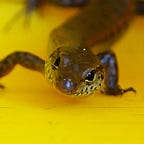Gardening for Butterflies
Forget pesticides and ignore the mower
It’s spring in the South and the butterflies are making their presence known. In my garden — which is mostly lawn, because I live in a rental property — Common Grass-blues (Zizina otis) are present in their hundreds. This is one of the most widespread species in Australia, abundant in parks and on sports ovals and in the gardens of people with a relaxed attitude to mowing. Common Grass-blue caterpillars have broad diets, feeding on a wide range of native and introduced peas (Fabaceae). The ubiquity of grassy spaces and weedy groundcover has contributed to the species’ survival in suburban spaces. Other butterflies have not been so successful.
I wrote about butterfly conservation and how to encourage butterflies into your garden. The key is caterpillar food plants, which means the gardener has to put up with a less than perfect display. The result is worth it.
Ragged leaves, untidy corners and no pesticides: how to plant a butterfly garden
The Richmond birdwing is a show-stopping butterfly. Males are black and dazzling green; females are black and white with a flashy gold trim. They are not easily overlooked as they flutter around subtropical rainforests between Ballina and the Sunshine Coast. For 80 years, the Richmond birdwing population declined…
